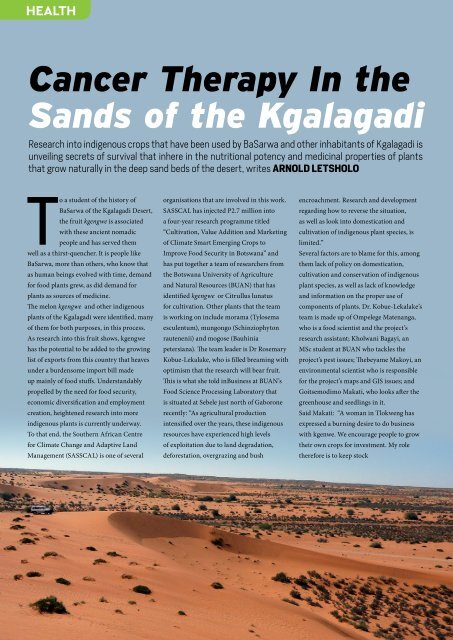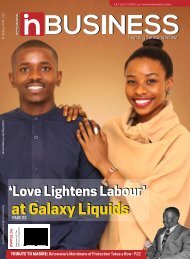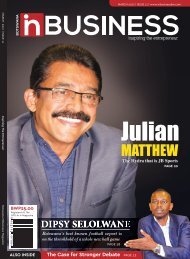inBUSINESS Issue 15
Create successful ePaper yourself
Turn your PDF publications into a flip-book with our unique Google optimized e-Paper software.
HEALTH<br />
Cancer Therapy In the<br />
Sands of the Kgalagadi<br />
Research into indigenous crops that have been used by BaSarwa and other inhabitants of Kgalagadi is<br />
unveiling secrets of survival that inhere in the nutritional potency and medicinal properties of plants<br />
that grow naturally in the deep sand beds of the desert, writes ARNOLD LETSHOLO<br />
To a student of the history of<br />
BaSarwa of the Kgalagadi Desert,<br />
the fruit kgengwe is associated<br />
with these ancient nomadic<br />
people and has served them<br />
well as a thirst-quencher. It is people like<br />
BaSarwa, more than others, who know that<br />
as human beings evolved with time, demand<br />
for food plants grew, as did demand for<br />
plants as sources of medicine.<br />
The melon kgengwe and other indigenous<br />
plants of the Kgalagadi were identified, many<br />
of them for both purposes, in this process.<br />
As research into this fruit shows, kgengwe<br />
has the potential to be added to the growing<br />
list of exports from this country that heaves<br />
under a burdensome import bill made<br />
up mainly of food stuffs. Understandably<br />
propelled by the need for food security,<br />
economic diversification and employment<br />
creation, heightened research into more<br />
indigenous plants is currently underway.<br />
To that end, the Southern African Centre<br />
for Climate Change and Adaptive Land<br />
Management (SASSCAL) is one of several<br />
organisations that are involved in this work.<br />
SASSCAL has injected P2.7 million into<br />
a four-year research programme titled<br />
“Cultivation, Value Addition and Marketing<br />
of Climate Smart Emerging Crops to<br />
Improve Food Security in Botswana” and<br />
has put together a team of researchers from<br />
the Botswana University of Agriculture<br />
and Natural Resources (BUAN) that has<br />
identified kgengwe or Citrullus lunatus<br />
for cultivation. Other plants that the team<br />
is working on include morama (Tylosema<br />
esculentum), mungongo (Schinziophyton<br />
rautenenii) and mogose (Bauhinia<br />
petersiana). The team leader is Dr Rosemary<br />
Kobue-Lekalake, who is filled breaming with<br />
optimism that the research will bear fruit.<br />
This is what she told inBusiness at BUAN’s<br />
Food Science Processing Laboratory that<br />
is situated at Sebele just north of Gaborone<br />
recently: “As agricultural production<br />
intensified over the years, these indigenous<br />
resources have experienced high levels<br />
of exploitation due to land degradation,<br />
deforestation, overgrazing and bush<br />
encroachment. Research and development<br />
regarding how to reverse the situation,<br />
as well as look into domestication and<br />
cultivation of indigenous plant species, is<br />
limited.”<br />
Several factors are to blame for this, among<br />
them lack of policy on domestication,<br />
cultivation and conservation of indigenous<br />
plant species, as well as lack of knowledge<br />
and information on the proper use of<br />
components of plants. Dr. Kobue-Lekalake’s<br />
team is made up of Ompelege Matenanga,<br />
who is a food scientist and the project’s<br />
research assistant; Kholwani Bagayi, an<br />
MSc student at BUAN who tackles the<br />
project’s pest issues; Thebeyame Makoyi, an<br />
environmental scientist who is responsible<br />
for the project’s maps and GIS issues; and<br />
Goitsemodimo Makati, who looks after the<br />
greenhouse and seedlings in it.<br />
Said Makati: “A woman in Tlokweng has<br />
expressed a burning desire to do business<br />
with kgenwe. We encourage people to grow<br />
their own crops for investment. My role<br />
therefore is to keep stock<br />
30<br />
www.inbusiness.co.bw | <strong>Issue</strong> <strong>15</strong> | 2017
















